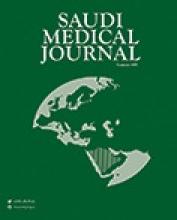Abstract
OBJECTIVE: To explore the relationship between self-reported weight and height to actual weight and height in a cross-sectional representative sample of school students in Jeddah City, Kingdom of Saudi Arabia and its relation to selected socio-economic and socio-demographic factors. Also to evaluate the validity of self-reported weight and height measurements.
METHODS: Data was collected from a sample of Saudi school students in Jeddah City, KSA from 42 boys' schools and 42 girls' schools during the month of April 2000. Data collection was carried out by an in-person interview to collect sociodemographic and self-reported weight and height, as well as, actual measurement of weight and height. Body mass index was classified according to age and genders into underweight (<15th percentile), normal weight (>=15th percentile to <85th percentile), overweight (>=85th percentile to <95th percentile) and obesity (>=95th percentile). Validity of self-reported obesity, as compared to measured body mass index, was assessed.
RESULTS: A total of 2,860 Saudi school students were enrolled in the study with an age range from 9 to 21 years (mean=13.9, standard deviation=2.8). Overweight was reported in 13.4% and obesity in 13.5% of school students. Overweight and obesity were more marked among those of at least 13 years of age, male of high social class and students with highly educated mothers. Slightly above half of the school children were unaware of their weight and height giving an unknown body mass index in approximately 60% of cases. Among the remaining 40% who reported their weight and height, underestimation of weight was around 2.7 kg and was mainly among girls, in 16-21 year old group, high socio-economic class and born from educated mothers. Overestimation of height by 4cm was reported mainly among the overweight, obese, girls, those with at least 16 years of age. Sensitivity of determining obesity by reported weight and height was low especially among girls and those of at least 16-years of age while specificity was more among boys than girls and improved by increase in age.
CONCLUSION: Our results display the inaccuracy of self-reported weight and height in tracking obesity in our youth population. These results also emphasize the need for community and school based programs for preventing and reducing obesity in school age through improving the nutritional status awareness, diet habits and life style in order to ensure health and longevity.
- Copyright: © Saudi Medical Journal
This is an open-access article distributed under the terms of the Creative Commons Attribution-Noncommercial-Share Alike 3.0 Unported, which permits unrestricted use, distribution, and reproduction in any medium, provided the original work is properly cited.






